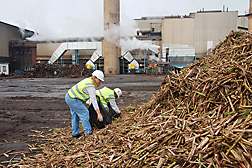This page has been archived and is being provided for reference purposes only. The page is no longer being updated, and therefore, links on the page may be invalid.
| Read the magazine story to find out more. |
|
|
Controlling Starch in Sugar Factories
By Rosalie Marion BlissJune 9, 2011
Factory trials conducted by U.S. Department of Agriculture (USDA) scientists have led to recommendations for controlling or preventing starch buildup in processed raw sugars and products made with those sugars. The study was led by chemist Gillian Eggleston with the Agricultural Research Service (ARS) Commodity Utilization Research Unit in New Orleans, La. ARS is USDA's chief intramural scientific research agency.
Eggleston has been studying sugarcane that comes into factories containing too much field leafy residue called trash. Environmental concerns have led to a shift away from burning cane in open fields to remove such trash. That means more trash or green cane is entering factories. Another challenge: Processing green, unburnt cane results in excess starch in raw and refined sugars, molasses and food products.
An enzyme called amylase is added during U.S. sugar-factory processing to break down long chains of unwanted starch. Eggleston conducted trials in three Louisiana-based factories using an amylase that was intermediate-temperature (IT) stable and in a concentrated form.
Eggleston used diluted solutions of concentrated amylase to improve contact between the amylase and starch. The solutions break starch down into smaller, more manageable molecules when added to factory tanks.
One of the solutions she tested contained concentrated IT-stable amylase diluted three-fold in water at the factory. When this solution was added at a dose of 2 parts per million (ppm) per ton of cane juice, starch breakdown was about 32 percent. When the dose was raised to 5 ppm per ton of cane juice, starch breakdown increased to 42 percent.
In addition, adding the amylase to the next-to-the-last evaporator—instead of the last evaporator as is traditional—improved starch breakdown even more. Another plus: Using diluted solutions of concentrated amylase is more cost-effective than using undiluted non-concentrated amylase.
Results from this work were published in a two-part paper in the International Sugar Journal.
Read more about this research in the May/June 2011 issue of Agricultural Research magazine.

